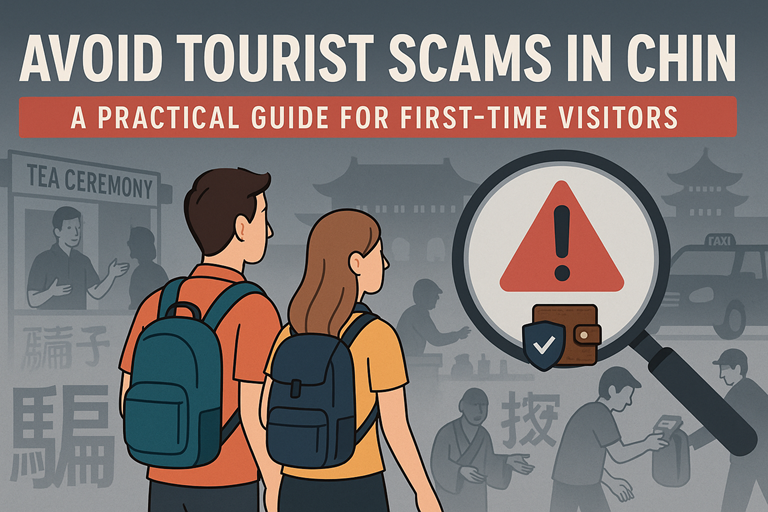Free Wi-Fi Hotspots in China: A Guide to Getting Connected on the Go
While purchasing a local SIM card or using an eSIM is highly recommended for consistent internet access in China, there will inevitably be times when you’ll look for free Wi-Fi. This guide will help you navigate the challenges of connecting to free Wi-Fi in China.
I. The Ubiquitous but Tricky Nature of Free Wi-Fi in China

Finding and connecting to free Wi-Fi in China can be challenging for international visitors
Free Wi-Fi (免费无线网络 – Miǎnfèi Wúxiàn Wǎngluò or 免费WiFi – Miǎnfèi WiFi) is available in many public and commercial spaces across Chinese cities. However, the biggest hurdle for international tourists is the real-name registration system, which often requires users to log in by receiving an SMS verification code (验证码 – Yànzhèngmǎ) on a Chinese mobile phone number.
Key Challenges for Tourists:
- SMS Verification: Most free public Wi-Fi networks require you to enter a Chinese mobile number to receive a verification code via SMS. If you don’t have a local SIM, this can be a significant barrier.
- Language: Captive portal login pages are often entirely in Chinese, though some international brands or tourist spots might have English options.
- Speed and Reliability: Free Wi-Fi can be slow, especially if many users are connected. Reliability can also vary.
- Security: As with any public Wi-Fi, security can be a concern. Always use a VPN for sensitive activities.
- The Great Firewall (GFW): Even when connected to Wi-Fi, you’ll still be behind the GFW. To access blocked international sites (Google, Facebook, Instagram, X, WhatsApp, etc.), you will need a functioning VPN.
Despite these challenges, let’s explore where you can typically find these hotspots.
II. Prime Locations for Free Wi-Fi Hotspots
Airports (机场 – Jīchǎng)
Availability: Most international and major domestic airports in China offer free Wi-Fi. This is often the easiest place for tourists to get connected upon arrival.
Connection Process:
- Look for Wi-Fi kiosks/machines specifically designed for obtaining Wi-Fi access codes. These often allow you to scan your passport to generate a username and password or a temporary access code, bypassing the need for a Chinese phone number.
- Alternatively, some airport networks might allow direct login after accepting terms and conditions, or may have an option to receive the SMS code to an international number (less common, and international SMS charges might apply from your home carrier).
- Network names (SSIDs) are usually clearly indicated (e.g., “AIRPORT-FREE-WIFI,” “[CityName]-Airport-Free”).
Example: Beijing Capital International Airport (PEK), Shanghai Pudong International Airport (PVG), Guangzhou Baiyun International Airport (CAN) all have relatively user-friendly Wi-Fi for international passengers.
Hotels and Hostels (酒店 – Jiǔdiàn / 旅社 – Lǚshè)
Availability: Virtually all hotels and hostels provide free Wi-Fi for their guests. This is usually the most reliable source of free internet during your stay.
Connection Process:
- The Wi-Fi network name (SSID) and password (密码 – Mìmǎ) are typically provided at check-in, displayed in your room, or available from the front desk.
- Some hotels might have a system where you log in with your room number and surname.
- No SMS verification is usually required for hotel guest Wi-Fi.
Tip: Confirm Wi-Fi availability and if it’s free throughout the property (rooms and common areas) when booking.

Hotels are among the most reliable sources of free Wi-Fi for travelers in China
Cafés (咖啡馆 – Kāfēi Guǎn)
International Chains (e.g., Starbucks – 星巴克 Xīngbākè, Costa Coffee):
Availability: Widely available.
Connection Process:
Often requires a Chinese mobile number for SMS verification. Some Starbucks locations might offer alternative login methods if you have their app and are a member, or sometimes staff might be able to help you get a code if you ask politely (no guarantee). In some cases, they might have a generic login that doesn’t require SMS, but this is becoming rarer.
Local Chains and Independent Cafés:
Availability: Many offer free Wi-Fi to attract customers.
Connection Process: SMS verification with a Chinese number is very common. Sometimes the password might be printed on a receipt after a purchase, or displayed somewhere in the café. Don’t hesitate to ask staff: “请问,WiFi密码是多少?” (Qǐngwèn, WiFi mìmǎ shì duōshao? – Excuse me, what is the Wi-Fi password?).
Fast Food Restaurants (快餐店 – Kuàicān Diàn)
Examples: McDonald’s (麦当劳 – Màidāngláo), KFC (肯德基 – Kěndéjī), Pizza Hut (必胜客 – Bìshèngkè).
Availability: Most outlets offer free Wi-Fi.
Connection Process: Typically requires SMS verification with a Chinese phone number. The login portal usually appears after connecting to their network.
Shopping Malls (购物中心 – Gòuwù Zhōngxīn / 商场 – Shāngchǎng)
Availability: Many modern shopping malls provide complimentary Wi-Fi in common areas.
Connection Process: Can vary. Some might have a simple click-to-accept terms page, but many will require SMS verification. Look for signs advertising free Wi-Fi and instructions, or check with an information desk.
Train Stations (火车站 – Huǒchē Zhàn), especially High-Speed Rail Stations
Availability: Increasingly common, particularly in major high-speed rail hubs.
Connection Process: Almost universally requires a Chinese mobile number for SMS verification. This can be frustrating for tourists trying to kill time before a train. Some stations might have Wi-Fi help desks, but access without a local number is difficult.
Some Metro/Subway Stations (地铁站 – Dìtiě Zhàn)
Availability: Less common for platform-wide Wi-Fi compared to other venues, but some major interchange stations in top-tier cities might offer it.
Connection Process: If available, likely to require SMS verification.
Public Libraries (图书馆 – Túshū Guǎn) and Museums (博物馆 – Bówùguǎn)
Availability: May offer free Wi-Fi, but access might be more restricted or require a library card/visitor registration.
Connection Process: Could involve SMS verification or a specific login procedure provided by the institution.
Onboard Some Long-Distance Trains or Buses (火车/大巴 – Huǒchē/Dàbā)
Availability: Some newer high-speed trains or long-distance buses advertise onboard Wi-Fi.
Connection Process: Often requires SMS verification.
Reliability: Generally, onboard Wi-Fi on public transport in China is notoriously unreliable, slow, or offers very limited bandwidth. Don’t count on it for anything critical.
III. How to Connect: General Steps & Navigating Login Portals

Typical Chinese Wi-Fi login portal requiring SMS verification
- Enable Wi-Fi: Go to your device’s settings and turn on Wi-Fi.
- Select Network: Scan for available networks. Choose the one that seems to be the official free offering (e.g., “[BrandName]-Free-WiFi,” “ChinaNet,” “CMCC-FREE”).
- Captive Portal: Once connected, a browser window (captive portal) should automatically open. If not, open your web browser and try to navigate to any non-HTTPS website (e.g., neverssl.com or http://example.com) to trigger it.
- Login Page: This is where it gets tricky.
- Look for English Options: Scan the page for “English” or a language selection icon.
- SMS Verification: The most common method. You’ll see a field to enter your phone number (手机号码 – Shǒujī Hàomǎ) and a button to get a verification code (获取验证码 – Huòqǔ Yànzhèngmǎ). Once received, enter the code in the appropriate field and click “Login” (登录 – Dēnglù) or “Connect” (连接 – Liánjiē).
- WeChat Login (微信登录 – Wēixìn Dēnglù): Some networks allow login via WeChat. If you have WeChat set up and functioning, this can be an option. You’ll typically scan a QR code or authorize through your WeChat app.
- Password Only: In some cafes or smaller establishments, they might just give you a direct password.
- Account Creation: Less common for free Wi-Fi, but some might ask you to create a simple account.
IV. Overcoming the SMS Verification Challenge (Without a Local SIM)
This is the main hurdle. Here are some potential (but not guaranteed) workarounds:
Airport Kiosks
As mentioned, airports are your best bet for SMS-free Wi-Fi via passport scanning kiosks.
Ask Staff for Help
In cafes or restaurants, politely ask staff if they can help you connect. They might use their own phone number to get you a code, or they might have a temporary access code for customers. Success varies greatly. A phrase like “你好,我没有中国手机号码,可以帮我连接WiFi吗?” (Nǐ hǎo, wǒ méiyǒu Zhōngguó shǒujī hàomǎ, kěyǐ bāng wǒ liánjiē WiFi ma? – Hello, I don’t have a Chinese mobile number, can you help me connect to the Wi-Fi?) could be useful.
Use WeChat Wi-Fi Feature
If a hotspot supports “WeChat Wi-Fi Friend” (微信连WiFi), and you have WeChat, you might be able to connect through the app.
“Wi-Fi Master Key” (WiFi万能钥匙 – WiFi Wànnéng Yàoshi) & Similar Apps
These apps claim to share Wi-Fi passwords crowdsourced from users.
Caution: Use these with extreme caution. They raise significant privacy and security concerns as they often require extensive permissions and upload your own network details. While popular in China, they are generally not recommended for security-conscious travelers.
V. The Best Strategy: Don’t Rely Solely on Free Wi-Fi

A local SIM card provides the most reliable internet access in China
While it’s good to know where to find free Wi-Fi, it shouldn’t be your primary method of staying connected in China due to the inconsistencies and login hurdles.
Get a Local SIM Card
The most reliable solution. Provides data access anywhere, anytime, and gives you a Chinese number for SMS verification if needed for other services or Wi-Fi hotspots.
Use an eSIM
If your phone supports it, an eSIM for China can be purchased and activated before your trip, offering data access upon arrival. Some eSIMs route traffic internationally, potentially bypassing the GFW without needing a separate VPN (check with the provider).
Pocket Wi-Fi Device
Rent or buy one. It uses a local SIM to create a personal hotspot for multiple devices.
VI. Security Tips for Using Public Wi-Fi in China (and Anywhere)
Public Wi-Fi networks, while convenient, can expose your personal information to hackers and other malicious actors. These risks are compounded in China where all internet traffic is monitored by the Great Firewall.
- Always Use a VPN: This is non-negotiable in China, not just for accessing blocked sites but also for encrypting your connection on public Wi-Fi, protecting your data from snooping. Connect to your VPN after connecting to the Wi-Fi but before doing anything else.
- Avoid Sensitive Transactions: Refrain from online banking, entering credit card details, or accessing confidential information on public Wi-Fi unless absolutely necessary and with a trusted VPN active.
- Look for HTTPS: Ensure websites use “HTTPS” (the ‘S’ stands for secure) in the URL, indicated by a padlock icon in your browser’s address bar.
- Keep Software Updated: Ensure your device’s operating system, browser, and security software are up to date.
- Disable Auto-Connect: Turn off the feature that automatically connects your device to open Wi-Fi networks.
- “Forget” Networks: After you’re done using a public Wi-Fi network, tell your device to “forget” it so it doesn’t automatically reconnect later without your knowledge.
- Be Wary of “Free” Unsecured Networks: If a network looks suspicious or too good to be true (e.g., an open network in an unusual place), it’s best to avoid it.
VII. Conclusion
Free Wi-Fi hotspots are indeed present across urban China, offering potential connectivity points for travelers. Airports and your accommodation are generally the most reliable sources. However, the prevalent SMS verification system using a local Chinese number poses a significant challenge. While workarounds exist, they are not always dependable.
For a stress-free and consistently connected experience in China, supplementing your free Wi-Fi hunts with a local SIM card or an eSIM is highly advisable. And remember, regardless of how you connect to the internet in China, a reliable VPN is your key to accessing the global web and protecting your online privacy. Happy (and safe) surfing!

Enjoyed this article? Consider buying me a coffee to support more content like this!
💖 0 people have clicked to support this article.


